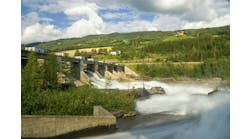A transmitter damping setting or signal filter setting that is too slow can not only degrade performance but also cause trips. Less understood is that a large filter setting can mislead operations into thinking the filter has helped rather than hurt the process. Too fast of a damping setting or filter setting can decrease the signal to noise ratio and inflict disturbances on the respective loop and other loops. So far as control valves, noise causing the valve to move can be a problem or a solution.
The transmitters damping setting and signal filter setting should be less than the rate time and less than 10% of the integral time assuming the PID execution time is negligible. The signal filters and damping should be less than 0.2 seconds for compressor control. For Analog Control Holdouts damping and filtering should be less than 0.1 seconds since these loops have integral times faster than 1 second.
A sensor time constant, transmitter damping setting, or signal filter in the Analog Input (AI) block or PID block introduces a measurement lag (time constant). A really insidious situation occurs when the measurement lag becomes the largest time constant in the loop. In PID tuning equations, the so called process time constant is really the largest time constant no matter where it appears in the loop. Ideally, you want the largest time constant to be in the process just downstream of the point of entry of the disturbance so that it slows down the upset giving time for the PID to compensate for it as discussed in What Have I Learned? To Lag or Not to Lag?
If the measurement lag is the largest time constant in the loop, the plots will be smoother and the controller gain can be increased leading one to think a big measurement filter is the best idea ever. I have been at an ISA conference where the presenter said he almost did not get permission to give the paper because his company thought he was giving away a proprietary advantage. He had added a filter so large, everything was so smooth. He did not plot the actual process variable. When we have excessively slow sensors, transmitters, or filtered signals, we do not know what the actual process is doing. Making a sensor or transmitter faster may make a measurement look worse so if possible keep the old slow measurement to show the improvement from faster control. Low velocities, low heat transfer coefficients, low thermal conductivity protection tubes, and thermowell air gaps for temperature measurements, and low mass transfer coefficients, old glass, thick glass and low pH can make pH electrodes slow. Coatings can add a huge measurement lag especially for pH electrodes. The amplitude of the actual process variable can be estimated from the amplitude of the measurement by Equation 1-3 on page 56 of the ISA book Essentials of Modern Measurements and Final Elements. For more on the deception see So Smooth
To show how serious the problem can be for seemly innocuous damping settings, a user said in the Control Talk column Sensible Sensor Speeds - Part 1 “In the past few years, I have twice seen major equipment accepted into service and then malfunction. One was the lube oil system of a wet gas compressor where the standby pump didn’t start quickly enough. The other was when two gas export compressors had serious problems with the anti-surge system and load-sharing functions. In both cases, the problem came down to pressure transmitters that had been installed with factory defaults for the transmitter damping of a generous 2 seconds. My control and instrumentation colleagues were quick to point fingers in all other directions, as they had tuned the loops personally (or instructed their reports to do so) and could see no problems. I have twice found damping left at factory presets to be the major or only cause of problems. None of the data relating to the instruments makes a big deal about this. Is this where the problem lies? I wish I knew where all the similar problems in the world were because I am sure I could be a very wealthy person based just on this knowledge alone. Based on my findings, the savings are probably in excess of $2 million per annum.”
What about measurement noise and A/D noise in slow loops (e.g. vessel temperature or pH control)? In these cases, the signal filter should be adjusted to keep the fluctuations in controller output from noise within the deadband of the final control element (e.g. control valve or variable frequency drive) so the final element does not change the flow in response to noise inflicting disturbances. Even the best air actuated valve has a deadband of about 0.2%. Variable frequency drives may have a deadband in the drive setup.
In some cases some valve movement in response to noise can help keep the valve from seizing and can reduce stiction and the associated time delay.




